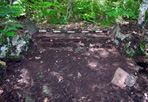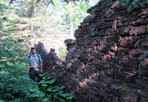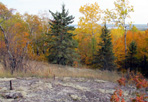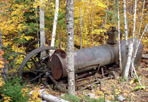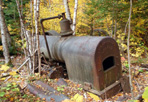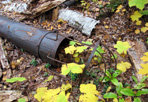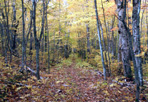
Island Mine
By: Lawrence Rakestraw
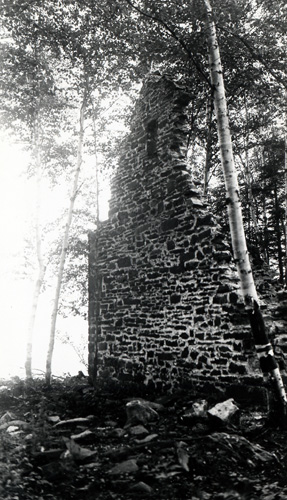
Powder House Ruins, Senter Point, 1964/1965: Rakestraw Collection (NVIC: 50-958), ISRO Archives.
n the south side of the island an equally ambitious but shorter-lived operation grew up. S. W. Hill's party discovered a large number of Indian pits to the north of Siskiwit Bay. The Island Mining Company was organized in 1873, and that fall a force of 80 men reported for work on the island. With over 400,000 board feet of lumber shipped to the island, they laid out a townsite on the north side of Siskiwit Bay and built a road two miles to the mine. The group passed the first winter without incident. On March 19, 1874 two men wrote to the Portage Lake Mining Gazette from the settlement:
Rev. Father Baxter, Jesuit missionary, arrived from Silver Islet yesterday, accompanied by three men, leaving there the day before. Today the reverend gentleman is busy among the Catholic population. He reports the ice strong, and thinks a horse team could cross with safety between here and Silver Islet. A number of people have crossed on the ice this year to visit us. It seems strange owing to the fact that the weather has been reasonably mild and pleasant; still, the ice is strong. We are not so isolated after all. Our people are all well and in good spirits. There has not been a single case of sickness, nor one injured at the mine. Four men met with an accident while quarrying rock at the dock last fall, but they are all out now. Everybody seems to be contented, and there has not been a single breach of peace since close of navigation. This is not bad for a population of 130 people.Yours truly,
Pick and Gad
During the next two years ambitious plans were carried out. Three shafts were opened, ultimately reaching depths of 50, 150, and 200 feet, the deeper ones connected with one another by drifts. A village was built at the mine location, a large hoist was hauled in, and a stone powder house constructed at Senter Point. A sawmill was set up, probably at the mouth of Caribou Creek. Original plans had been to build a stamp mill by the shore, to flume water down from a dam near the mine site, and to build a railroad from the mine site to the stamp mill. However, only part of this was accomplished. A massive earth-fill dam was constructed, and a railroad bed laid down as far as the creek on which the dam was located. Then came a series of disasters. The dock and warehouse burned in 1874, and the fire swept nearly up to the mining location. The price of copper fell. Investors lost confidence. On September 23, 1875, the Portage Lake Mining Gazette reported that all work on the Island Mine had ceased. The conglomerate, rich enough near the surface, had become poorer at greater depths; and the lode was "bunchy." The company cancelled contracts for lumber and stamp mill machinery, and all available supplies, including the tug May thorn, were offered for sale. One man was left as caretaker for the village.
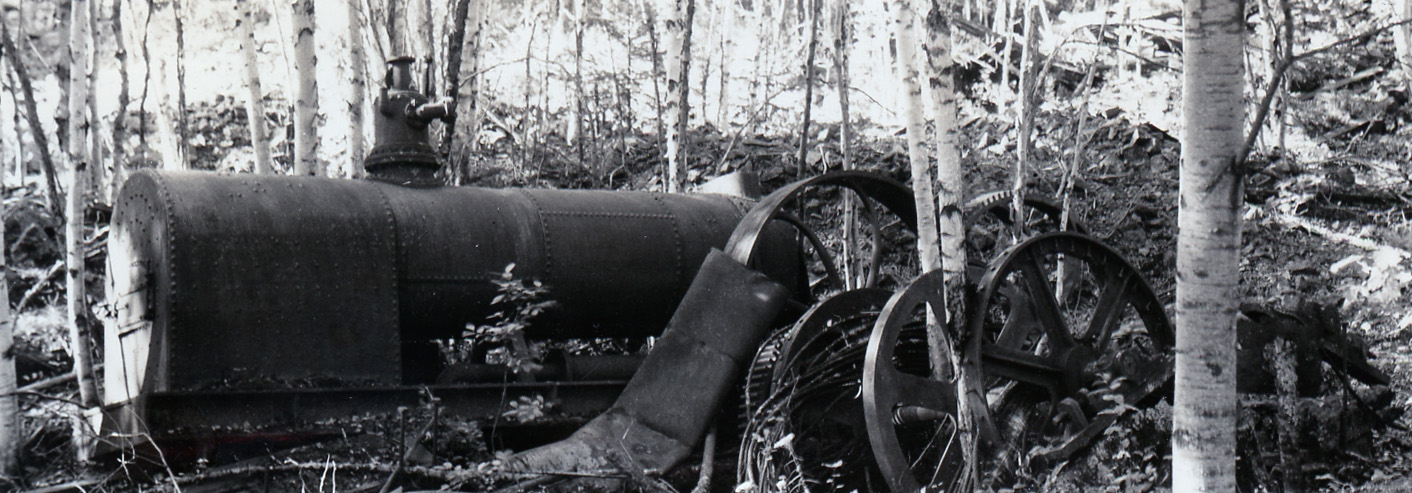
Abandoned Steam Hoist, Island Mine, 1935: Wolbrink Collection (NVIC: 30-371), ISRO Archives.
Tributors worked the mine for three years, doing some stoping, but largely using the rock already excavated. They built a small stamp mill on a creek near the mine location, using for water and transportation the dam and railroad already in place, but they, too, were beset with frus-trations including the burning of their mill. It was not long before they had abandoned the place. In 1881 Alexander Winchell, the Minnesota state geologist, found the buildings and machinery still on the shore, but soon thereafter the warehouse burned, and today the townsite shows little signs of its former occupancy.
Status
Only three structures remain in the form of ruins: a well, a powder house, and an old tramway grade.
The powder house was built of native sandstone using irregular coursing masonry method, and is currently a ruin. It is 40' x 20'8", and the roof has collapsed, but portions of four walls remained standing in 1994. The north wall is 12' tall, and has the building's only door. The original cast iron frame lies in the doorway (door was extant in 1960s). The building has large corner stones and the interior walls consist of a rough, untooled mortar finishing.
Image Gallery
Citation:
- National Park Service Cultural Landscapes Inventory. 2010. Island Mining Company Powder House. Park Historic Architecture and Cultural Landscapes Program, U.S. National Park Service.
- Rakestraw, L., United States., & Isle Royale Natural History Association. (1965). Historic mining on Isle Royale. Houghton, Mich.: Isle Royale Natural History Association in cooperation with the National Park Service.
![Abandoned Steam Hoist, 1935: Wolbrink [NVIC: 30-371], ISRO Archives.](../Island_Mine/Jpegs/Small/NVIC-30-371.jpg)
![Island Mine Ruins, 1938: Kieley [NVIC: 30-162], ISRO Archives.](../Island_Mine/Jpegs/Small/NVIC-30-162.jpg)
![Island Mine Ruins, 1938: Kieley [NVIC: 30-163], ISRO Archives.](../Island_Mine/Jpegs/Small/NVIC-30-163.jpg)
![Island Mine Ruins, 1938: Kieley [NVIC: 30-164], ISRO Archives.](../Island_Mine/Jpegs/Small/NVIC-30-164.jpg)
![Island Mine Ruins, 1938: Kieley [NVIC: 30-165], ISRO Archives.](../Island_Mine/Jpegs/Small/NVIC-30-165.jpg)
![Island Mine Ruins, 1938: Kieley [NVIC: 30-166], ISRO Archives.](../Island_Mine/Jpegs/Small/NVIC-30-166.jpg)
![Island Mine Ruins, 1938: Kieley [NVIC: 30-167], ISRO Archives.](../Island_Mine/Jpegs/Small/NVIC-30-167.jpg)
![Island Mine Ruins, 1938: Kieley [NVIC: 30-168], ISRO Archives.](../Island_Mine/Jpegs/Small/NVIC-30-168.jpg)
![Island Mine Ruins, 1938: Kieley [NVIC: 30-169], ISRO Archives.](../Island_Mine/Jpegs/Small/NVIC-30-169.jpg)
![Abandoned Steam Hoist, 1938: Kieley [NVIC: 30-170], ISRO Archives.](../Island_Mine/Jpegs/Small/NVIC-30-170.jpg)
![Island Mine Ruins, 1938: Kieley [NVIC: 30-364], ISRO Archives.](../Island_Mine/Jpegs/Small/NVIC-30-364.jpg)
![Powder House Ruins, 1950s: [NVIC: 50-958], ISRO Archives.](../Island_Mine/Jpegs/Small/NVIC-50-958.jpg)
